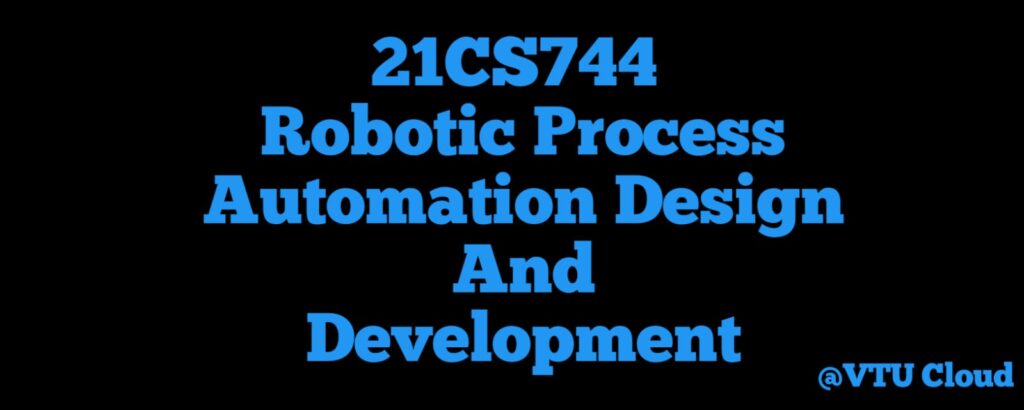21CS744 Robotic Process Automation Design And Development

Course Learning Objectives
CLO 1. To understand basic concepts of RPA
CLO 2. To Describe RPA, where it can be applied and how its implemented
CLO 3. To Describe the different types of variables, Control Flow and data manipulation
techniques
CLO 4. To Understand Image, Text and Data Tables Automation
CLO 5. To Describe various types of Exceptions and strategies to handle
SYLLABUS COPY
MODULE - 1
RPA Foundations- What is RPA – Flavors of RPA- History of RPA- The Benefits of RPA- The downsides of RPA- RPA Compared to BPO, BPM and BPA – Consumer Willingness for Automation- The Workforce of the Future- RPA Skills-On-Premise Vs. the Cloud- Web Technology- Programming Languages and Low Code- OCR-Databases-APIs- AI-Cognitive Automation-Agile, Scrum, Kanban and Waterfall0 DevOps- Flowcharts.
MODULE - 2
RPA Platforms- Components of RPA- RPA Platforms-About Ui Path- About UiPath – The future of automation – Record and Play – Downloading and installing UiPath Studio -Learning Ui Path Studio- – Task recorder – Step-by-step examples using the recorder.
MODULE - 3
Sequence, Flowchart, and Control Flow-Sequencing the workflow-Activities-Control flow, various types of loops, and decision making-Step-by-step example using Sequence and Flowchart-Step-by-step example using Sequence and Control flow-Data Manipulation-Variables and Scope-CollectionsArguments – Purpose and use-Data table usage with examples-Clipboard management-File operation with step-by-step example-CSV/Excel to data table and vice versa (with a step-by-step example).
MODULE - 4
Taking Control of the Controls- Finding and attaching windows- Finding the control- Techniques for waiting for a control- Act on controls – mouse and keyboard activities- Working with UiExplorerHandling events- Revisit recorder- Screen Scraping- When to use OCR- Types of OCR available- How to use OCR- Avoiding typical failure points.
MODULE - 5
Exception Handling, Debugging, and Logging- Exception handling- Common exceptions and ways to handle them- Logging and taking screensHOT- Debugging techniques- Collecting crash dumps- Error reporting- Future of RPA
Course outcome
CO 1. To Understand the basic concepts of RPA
CO 2. To Describe various components and platforms of RPA
CO 3. To Describe the different types of variables, control flow and data manipulation techniques
CO 4. To Understand various control techniques and OCR in RPA
CO 5. To Describe various types and strategies to handle exceptions
Suggested Learning Resources
Textbooks 1. Tom Taulli , The Robotic Process Automation Handbook : A Guide to Implementing RPA Systems, 2020, ISBN-13 (electronic): 978-1-4842-5729-6, Publisher : Apress
2. Alok Mani Tripathi, Learning Robotic Process Automation, Publisher: Packt Publishing Release
Date: March 2018 ISBN: 9781788470940 Reference 1. Frank Casale, Rebecca Dilla, Heidi Jaynes, Lauren Livingston, “Introduction to Robotic Process Automation: a Primer”, Institute of Robotic Process Automation. 2. Richard Murdoch, Robotic Process Automation: Guide To Building Software Robots, Automate Repetitive Tasks & Become An RPA Consultant
3. Srikanth Merianda,Robotic Process Automation Tools, Process Automation and their benefits:
Understanding RPA and Intelligent Automation